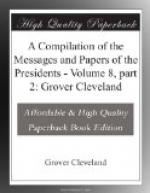A review of the legislation which has been had upon this subject during the last thirty years discloses that domestic letters constitute the only class of mail matter which has never been favored by a substantial reduction of rates. I am convinced that the burden of maintaining the service falls most unequally upon that class, and that more than any other it is entitled to present relief.
That such relief may be extended without detriment to other public interests will be discovered upon reviewing the results of former reductions.
Immediately prior to the act of 1845 the postage upon a letter composed of a single sheet was as follows:
If conveyed— Cents.
30 miles or less 6 Between 30 and 80 miles 10 Between 80 and 150 miles 12-1/2 Between 150 and 400 miles 18-3/4 Over 400 miles 25
By the act of 1845 the postage upon a single letter conveyed for any distance under 300 miles was fixed at 5 cents and for any greater distance at 10 cents.
By the act of 1851 it was provided that a single letter, if prepaid, should be carried any distance not exceeding 3,000 miles for 3 cents and any greater distance for 6 cents.
It will be noticed that both of these reductions were of a radical character and relatively quite as important as that which is now proposed.
In each case there ensued a temporary loss of revenue, but a sudden and large influx of business, which substantially repaired that loss within three years.
Unless the experience of past legislation in this country and elsewhere goes for naught, it may be safely predicted that the stimulus of 33-1/3 per cent reduction in the tax for carriage would at once increase the number of letters consigned to the mails.
The advantages of secrecy would lead to a very general substitution of sealed packets for postal cards and open circulars, and in divers other ways the volume of first-class matter would be enormously augmented. Such increase amounted in England, in the first year after the adoption of penny postage, to more than 125 per cent.
As a result of careful estimates, the details of which can not be here set out, I have become convinced that the deficiency for the first year after the proposed reduction would not exceed 7 per cent of the expenditures, or $3,000,000, while the deficiency after the reduction of 1845 was more than 14 per cent, and after that of 1851 was 27 per cent.
Another interesting comparison is afforded by statistics furnished me by the Post-Office Department.
The act of 1845 was passed in face of the fact that there existed a deficiency of more than $30,000. That of 1851 was encouraged by the slight surplus of $132,000. The excess of revenue in the next fiscal year is likely to be $3,500,000.




